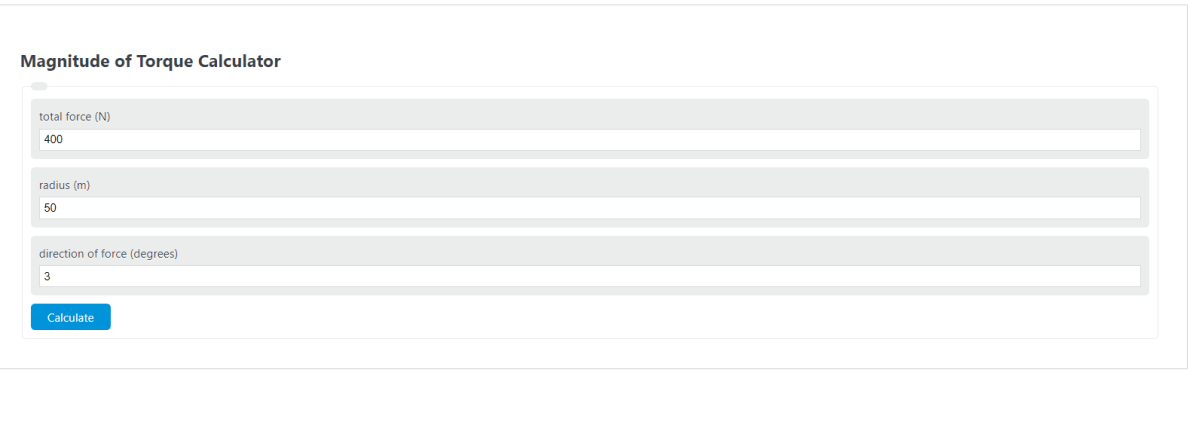Enter the total force (N), the radius (m), and the direction of force (degrees) into the calculator to determine the Magnitude of Torque.
Magnitude of Torque Formula
The following formula is used to calculate the Magnitude of Torque.
Tm = F*r*sin(a)
- Where Tm is the Magnitude of Torque (N-m)
- F is the total force (N)
- r is the radius (m)
- a is the direction of force (degrees)
To calculate the magnitude of the torque, multiply the force, radius, and sine of the angle of the force.
How to Calculate Magnitude of Torque?
The following example problems outline how to calculate Magnitude of Torque.
Example Problem #1
- First, determine the total force (N). In this example, the total force (N) is determined to be 400 .
- Next, determine the radius (m). For this problem, the radius (m) is measured to be 50 .
- Next, determine the direction of force (degrees). In this case, the direction of force (degrees) is found to be 3.
- Finally, calculate the Magnitude of Torque using the formula above:
Tm = F*r*sin(a)
Inserting the values from above and solving yields:
Tm = 400*50*sin(3deg) = 1046.71 (N-m)
Example Problem #2
Using the same method as above, determine the variables required by the formula. For this example problem, these are:
total force (N) = 78
radius (m) = 40
direction of force (degrees) = 12
Enter these given values into the calculator or above yields:
Tm = 78*40*sin(12deg) = 648.68 (N-m)
FAQ
What is torque and why is it important in mechanical systems?
Torque is a measure of the force that can cause an object to rotate about an axis. It is crucial in mechanical systems because it determines the rotational effect of a force applied to a mechanical component. Understanding torque is essential for designing and analyzing the performance of engines, gears, and other rotating machinery.
How does the angle of force affect the magnitude of torque?
The angle of the force directly affects the magnitude of torque through the sine function in the torque calculation formula (Tm = F*r*sin(a)). As the angle changes, the sine of the angle also changes, which in turn affects the magnitude of torque. A force applied at a 90-degree angle to the lever arm (radius) generates the maximum possible torque.
Can torque be negative, and what does it signify?
Yes, torque can be negative. The sign of torque (positive or negative) indicates the direction of rotation. Positive torque causes a clockwise rotation, while negative torque results in a counterclockwise rotation. The direction is determined by the right-hand rule, where the thumb points along the axis of rotation and the fingers curl in the direction of the applied force.
